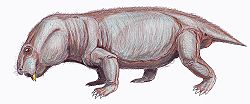Dicynodontoides recurvidens
|
Dicynodontoides Temporal range: Late Permian, 260–251 Ma |
|
|---|---|
 |
|
| Restoration of Dicynodontoides recurvidens | |
| Scientific classification | |
| Kingdom: | Animalia |
| Phylum: | Chordata |
| Clade: | Synapsida |
| Order: | Therapsida |
| Infraorder: | †Dicynodontia |
| Family: | †Kingoriidae |
| Genus: |
†Dicynodontoides Broom, 1940 |
| Species | |
|
|
| Synonyms | |
|
|
Dicynodontoides is a genus of small to medium-bodied, herbivorous, emydopoid dicynodont from the Late Permian. The name Dicynodontoides references its “dicynodont-like” appearance (dicynodont = two-dog-tooth) due to the caniniform tusks featured by most members of this infraorder. Kingoria, a junior synonym, has been used more widely in the literature than the more obscure Dicynodontoides, which is similar sounding to another distantly related genus of dicynodont, Dicynodon. Two species are recognized: D. recurvidens from South Africa, and D. nowacki from Tanzania.
Dicynodontoides is primarily known from fossil localities in South Africa and Tanzania, though several specimens unidentified to the species level are known from Zambia, Malawi, and India. Unlike several other members of the remarkably disparate emydopoid clade, Dicynodontoides did not survive into the Triassic, and its temporal distribution is restricted to the Late Permian.
Dicynodontoides was first described by Owen in 1876 based on a poorly preserved, but fairly complete skull and mandible, and was originally referred to the genus Dicynodon. The specimen was found in Fort Beaufort, South Africa, in the Dicynodon Assemblage Zone of the Karoo Basin. However, it wasn’t until Broom’s 1940 publication including Dicynodontoides parringtoni, a junior synonym for Owen’s D. recurvidens, that the genus was used. A second species, produced by the Usili Formation, D. nowacki, was first described by von Huene in 1942 from Kingori Mountain, Tanzania, and was originally referred to as Dicynodon nowacki.
Cox pointed out several features, most notably the hindlimb and girdle morphology, that differentiated this genus from other members of Dicynodon, and erected a new genus, Kingoria. Since, many researchers have attempted to place these ambiguous specimens within Dicynodontia. Not until the last decade has significant light been shed upon the matter, solidifying the place of the senior synonym, Dicynodontoides, and affirming the presence of only two species, D. recurvidens and D. nowacki.
...
Wikipedia
